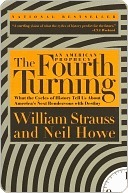More on this book
Community
Kindle Notes & Highlights
Read between
May 24 - June 18, 2025
the thesis of this book: that, within the next decade, America was due to enter a Fourth Turning, which we defined as a generation-long era of economic turbulence, institutional dysfunction, tribal partisanship, mounting internal and geopolitical emergencies, and (ultimately) public mobilization that would redefine our civic identity as a nation.
the generation-long era we foresaw did indeed begin about when we expected: in the middle of the 2000s decade. The new era was foreshadowed by the 9/11 attacks, began in earnest with the global financial crisis of 2008, and has thus far progressed along the bone-jarring crescendo all-too-familiar to Americans who have been following the headlines: the shrinking of the middle class, the “MAGA” rise of Donald Trump, the collapse of public trust in governing institutions, the harrowing pandemic emergency, the rise of scorched-earth political partisanship, the rise of authoritarian populists both
...more
Each cycle (or saeculum) lasts roughly eighty to one hundred years, the length of a long human life.
each saeculum is composed of four eras that we call “turnings” and that can be regarded either as seasons of history or as phases of a person’s life. A turning lasts about twenty years or so, and each turning (spring, summer, fall, winter) always arrives in the same order.
Each social generation (everyone born over a period of twenty years or so) is shaped young by history during childhood or while coming of age into adulthood. Forty to fifty years later, that same generation will, as parents and senior leaders, shape history—and thereby shape the world of another newly arriving generation. The generational experience is thus a closed cycle that not only beats to the same rhythm as the seasonal turning but also causally connects one turning to another.
the Hero archetype, for example, always grow up as protected children, come of age as team-working young achievers during a Crisis, demonstrate hubris as confident midlifers, and age into the engaged, powerful elders who preside over the next Awakening. This archetype fits the G.I. Generation, sometimes called the “greatest generation,” as G.I.s moved from their mid-twenties in 1940, to their mid-forties in 1960, to their mid-sixties in 1980.
Generations of the Prophet archetype, by contrast, grow up as increasingly indulged post-Crisis children, come of age as defiant young crusaders during an Awakening, cultivate principle as moralistic midlifers, and age into the detached, visionary elders who preside over the next Crisis. This archetype clearly fits Boomers as they have moved from their mid-twenties in 1980, to their mid-forties in 2000, to their mid-sixties in 2020.
adults of all ages were doing their best to extend a welcoming sense of protection, mission, and collective purpose to America’s newest generation of children (Millennials) and thereby set them on a different course than the older Xer kids they were replacing.
social time is a recurring cycle in which events become meaningful only to the extent that they are what philosopher Mircea Eliade calls “reenactments.”
By the mid-2030s, the winter season will yield to the spring season, and much that we now feel is hopelessly out of reach (community, public order, global peace, social equality, family values, civic trust) may actually be within our grasp.
A cyclical perspective on human events keeps us grounded. It offers us perspective and wisdom. And when adversity darkens our horizons, it even gives us hope.
Around World War II, we were proud as a people but modest as individuals. Fewer than two people in ten said yes when asked, Are you a very important person? Today, more than six in ten say yes.
Where we once thought ourselves collectively strong, we now regard ourselves as individually entitled.
In America, as Mark Twain observed, nothing is older than our habit of calling everything new.


